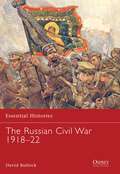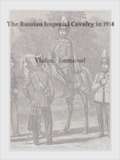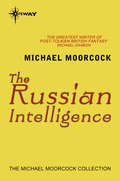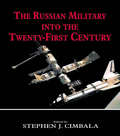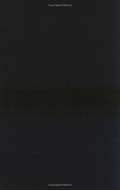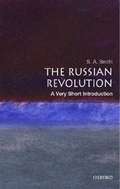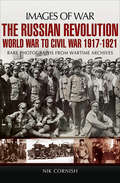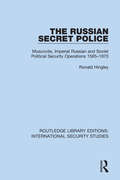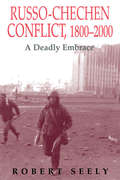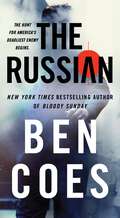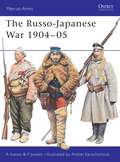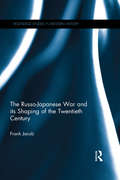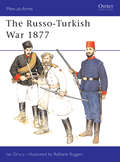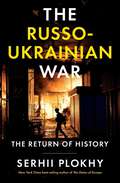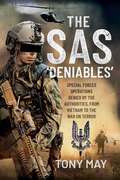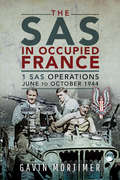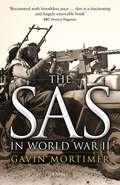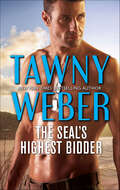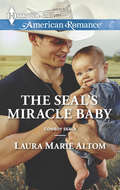- Table View
- List View
The Russian Civil War 1918-22
by David BullockThe Russian Civil War was the most important event of its kind in the 20th century. It changed the lives of over half a billion people and dramatically shaped the political, human and economic geography of Europe, the Far East and Central Asia. Over a tempestuous four-year period the Communist Red Army and the loosely formed, anti-Bolshevist White Army battled in a war that would totally transform the vast Eurasian heartland and lead to Communist revolutions worldwide as well as the Cold War. David Bullock offers a fresh perspective on this conflict, examining the forces of both sides, the intervention of non-Russian forces, including American, Canadian, British, and Japanese troops, and the involvement of female soldiers and partisans. The military story of massed infantry and cavalry actions, mechanized warfare with tanks, armored cars and trains, and air combat, all along rapidly shifting fronts, is told against the incredible backdrop of political and social revolution. It is an account that is interwoven with tragedy - 30 million people died during the Civil War - and the author skillfully places the battles in the context of human suffering as he explores the cruel sacrifice of a huge population on the altar of political power. The absorbing text includes dramatic first-hand accounts, and is vividly illustrated with carefully selected previously unpublished photographs. This new insight into history's most significant civil war, which began 90 years ago, will be welcomed by all students of history seeking a compact account of the conflict that brought into being a new superpower - the USSR - and its threatening ideology.
The Russian Imperial Cavalry in 1914
by Vladimir EmmanuelVladimir Emmanuel was a cavalry captain who fought against the Germans and later the Red Army in the Crimea. He created a wonderful set of color illustrations of the regiments he fought with in the early days of the war. The Russian Imperial Cavalry in 1914 details the uniforms of most of the Russian cavalry that went to war in 1914 as well as information from two WWI veterans, an explanation of ranks and order of battle. It is a must for the collect of anyone interested in the Great War and/or Russian military history.
The Russian Intelligence
by Michael MoorcockMeet secret agent, Jerry Cornell: the polar opposite if a super sleuth.Jerry is always careful to choose a case that will solve itself so he can spend most of his agency's time in bed with a beautiful woman. But his luck runs out when he accidentally takes on the the assignment code-named 'Devil Rider'.The Russian Intelligence is the hilarious sequel to The Chinese Agent.
The Russian Military into the 21st Century (Soviet (Russian) Military Theory and Practice)
by Stephen J. CimbalaThis work attempts to clarify the major problems facing Russia's armed forces in the present and immediate future. It covers threats from terrorists, break away republics and threats from outside Russia's borders. The book also includes political and economic problems facing the military.
The Russian Military: Power and Policy
by Steven E. Miller Dmitri V. TreninRussian military capacity remains a major consideration for global security even in the post-Soviet era. This book assesses today's Russian military and analyzes its possible future direction.
The Russian Revolution: A Very Short Introduction
by S. A. SmithThis Very Short Introduction provides an analytical narrative of the main events and developments in Soviet Russia between 1917 and 1936. It examines the impact of the revolution on society as a whole--on different classes, ethnic groups, the army, men and women, youth. Its central concern is to understand how one structure of domination was replaced by another. The book registers the primacy of politics, but situates political developments firmly in the context of massive economic, social, and cultural change. Since the fall of Communism there has been much reflection on the significance of the Russian Revolution. The book rejects the currently influential, liberal interpretation of the revolution in favour of one that sees it as rooted in the contradictions of a backward society which sought modernization and enlightenment and ended in political tyranny.
The Russian Revolution: World War to Civil War, 1917–1921 (Images of War)
by Nik CornishOften the drama of the October Revolution and the Bolshevik seizure of power overshadow the disastrous Russian-German war that preceded it and the extended, confusing, many-sided civil war between the Reds and the Whites that followed. But Nik Cornishs vivid photographic history gives equal coverage to each of these momentous events and shows how the Russian empire of the Romanovs was transformed into the Soviet dictatorship. Contemporary photographs show the leading characters in the drama Tsar Nicholas II, Kerensky, Lenin and Trotsky and other Bosheviks, and the White commanders Denikin, Kolchak, Wrangel and the rest. But they also record, in an unforgettable way, the ordinary people who were caught up in the surge of events civilian crowds on the city streets, peasant groups in the villages, the faces of common soldiers on all sides who fought on multiple fronts across Russia from Poland, the Baltic states and the White Sea to the Black Sea and Siberia. The scale of the conflict was remarkable, as was the intensity of the experience of those who took part and witnessed it, and this collection of historic photographs gives a poignant insight into the conditions of their time. It is a fascinating introduction to a period that saw a sea change in Russian history.
The Russian Revolution: World War to Civil War, 1917–1921 (Images of War)
by Nik CornishOften the drama of the October Revolution and the Bolshevik seizure of power overshadow the disastrous Russian-German war that preceded it and the extended, confusing, many-sided civil war between the Reds and the Whites that followed. But Nik Cornishs vivid photographic history gives equal coverage to each of these momentous events and shows how the Russian empire of the Romanovs was transformed into the Soviet dictatorship. Contemporary photographs show the leading characters in the drama Tsar Nicholas II, Kerensky, Lenin and Trotsky and other Bosheviks, and the White commanders Denikin, Kolchak, Wrangel and the rest. But they also record, in an unforgettable way, the ordinary people who were caught up in the surge of events civilian crowds on the city streets, peasant groups in the villages, the faces of common soldiers on all sides who fought on multiple fronts across Russia from Poland, the Baltic states and the White Sea to the Black Sea and Siberia. The scale of the conflict was remarkable, as was the intensity of the experience of those who took part and witnessed it, and this collection of historic photographs gives a poignant insight into the conditions of their time. It is a fascinating introduction to a period that saw a sea change in Russian history.
The Russian Secret Police: Muscovite, Imperial Russian and Soviet Political Security Operations 1565–1970 (Routledge Library Editions: International Security Studies #18)
by Ronald HingleyThis book, first published in 1970, is an important study of Russia’s security services from their earliest years to the mid-twentieth century. Ronald Hingley demonstrates how the secret police acted, both under the Tsars and under Soviet rule, as a key instrument of control exercised over all fields of Russian life by an outstandingly authoritarian state. He analyses the Tsarist Third Section and Okhrana and their role in countering Russian revolutionary groups, and examines the Soviet agencies as they assumed the roles of policeman, judge and executioner. This masterly evaluation of Russian and Soviet secret police makes extensive use of hard-to-find Russian documentary sources, and is the first such research that studies Russian political security (Muscovite, Imperial and Soviet) as a whole.
The Russian-Chechen Conflict 1800-2000: A Deadly Embrace (Soviet (Russian) Military Experience)
by Robert SeelyIn 1994, the mountain territory of Chechnya was witness to the largest military campaign staged on Russian soil since World War II. The Russo-Chechen war is examined within the context of the bitter history between the two peoples, culminating in the expression of conflict from 1994-1996.
The Russian: A Novel (Rob Tacoma #1)
by Ben Coes"This new series has me very excited." —Brad Thor As the brutal Russian mafia becomes the most powerful and deadly criminal enterprise in the U.S., it’s up to covert operative Rob Tacoma to fight back, in a new series by New York Times bestseller Ben Coes.Ruthless, clever, and unbelievably violent, the Russian mafia has rapidly taken over the criminal underworld in the U.S. and law enforcement has been unable to stem the tide. When a powerful Russian mob family declares war by publicly executing two high-profile American politicians, the message is unmistakable – opposition will be met with overwhelming deadly force. With no other viable options, the President creates a clandestine assassinations team to find and eliminate the unreachable men running this deadly criminal operation.The CIA recruits two Tier 1 operators – former Navy SEALs Billy Cosgrove and Rob Tacoma. But before they can even get started, the Russians act – murdering Cosgrove in his own home. Now Tacoma is on his own against an organization with endless resources and no boundaries. Step one requires the near impossible - find and kill the hidden mob boss behind Cosgrove’s death. To do this, he’ll have to take on an army in a battle where there are no rules and no limits.
The Russo-Japanese War 1904-05
by Andrei Karachtchouk Alexei IvanovThe Russo-Japanese War in Manchuria was the first 20th century conflict fought between the regular armies of major powers, employing the most modern means - machine guns, trench warfare, minefields and telephone communications; and the battle of Mukden in March 1905 was the largest clash of armies in world history up to that date. Events were followed by many foreign observers; but the events of 1914 in Western Europe suggest that not all of them drew the correct conclusions. For the first time in the West the armies of this distant but important war are described and illustrated in detail, with rare photos and the superbly atmospheric paintings of Russia's leading military illustrator.
The Russo-Japanese War and its Shaping of the Twentieth Century (Routledge Studies in Modern History)
by Frank JacobThe Russo-Japanese War was in essence a colonial conflict between the expanding interests of Russia and Japan in East Asia. However, while appearing regional, the war itself in fact had a major global impact. The conflict and Japanese victory stimulated the Russian revolutionary movement in 1905 and hence the Russian Revolution of 1917. In addition, the Peace Treaty of Portsmouth created a tension between the United States and Japan that would establish the starting point for the road directly leading to Pearl Harbor in 1941. Eventually the war had a major impact on Germany, whose diplomats wanted to use the war to bind St Petersburg to Berlin, and whose military planners closely observed the events to prepare themselves for the next possible conflict. This book makes a strong argument for the consideration of initially minor events in the analysis of global history. By describing and analyzing the interrelationship between the events in East Asia and the major developments in Europe and the United States, it shows the significance of the Russo-Japanese War as a key factor in determining the most momentous historical events of the twentieth century: The First World War, the Second World War, and the Cold War.
The Russo-Japanese War, Lessons Not Learned
by Major James D. SisemoreCharacterized by some authors as a rehearsal for the First World War, the Russo-Japanese War was arguably the world's first modern war. During this war, the lethality of weapons on the 20th Century battlefield was clearly demonstrated. Recording the events of the Russo-Japanese War were military and civilian observers from every major power of the time. These observers wrote voluminous accounts of the war that clearly illustrated this new battlefield destructiveness.The research question of this thesis is what tactical lessons were available to the observer nations of the Russo-Japanese War that were not used in their preparations for World War I. This paper will look at both observer accounts of the war and professional journal articles written soon after the war to consider this question. To answer this question, the stationary Siege of Port Arthur and the maneuver Battle of Mukden are used as representative battles of this war. Reports from these two battles clearly demonstrate the lethality of modern warfare and foreshadow the combined effects of hand grenades, mortars, machineguns, and field artillery in World War I.
The Russo-Turkish War 1877
by Raffaele Ruggeri Ian DruryOn 24 April 1877 Tsar Nicholas II declared war on the Ottoman Empire. The Sultan had a battle-hardened army ready for war. For the Tsar, this was to be the first major conflict since the abolition of serfdom and the creation of a German-style military reserve system. Ian Drury details the campaigns fought in the Russo-Turkish War of 1877, and the uniforms and organisation of the armies of both sides, in a text backed by numerous illustrations and photographs, including eight full page colour plates by Raffaele Ruggeri.
The Russo-Ukrainian War: The Return Of History
by Serhii PlokhyAn authoritative history of Europe’s largest military conflict since World War II, from the New York Times best-selling author of The Gates of Europe. Despite repeated warnings from the White House, Russia’s invasion of Ukraine in February 2022 shocked the world. Why did Putin start the war—and why has it unfolded in previously unimaginable ways? Ukrainians have resisted a superior military; the West has united, while Russia grows increasingly isolated. Serhii Plokhy, a leading historian of Ukraine and the Cold War, offers a definitive account of this conflict, its origins, course, and the already apparent and possible future consequences. Though the current war began eight years before the all-out assault—on February 27, 2014, when Russian armed forces seized the building of the Crimean parliament—the roots of this conflict can be traced back even earlier, to post-Soviet tensions and imperial collapse in the nineteenth and twentieth centuries. Providing a broad historical context and an examination of Ukraine and Russia’s ideas and cultures, as well as domestic and international politics, Plokhy reveals that while this new Cold War was not inevitable, it was predictable. Ukraine, Plokhy argues, has remained central to Russia’s idea of itself even as Ukrainians have followed a radically different path. In a new international environment defined by the proliferation of nuclear weapons, the disintegration of the post–Cold War international order, and a resurgence of populist nationalism, Ukraine is now more than ever the most volatile fault line between authoritarianism and democratic Europe.
The SAS 'Deniables': Special Forces Operations, denied by the Authorities, from Vietnam to the War on Terror
by Tony MayDuring the 10,000-day Vietnam war Australia had agreed with the United States to have a team of Australian Army Special Air Services (SAS) soldiers conduct covert missions into Cambodia. The SAS soldiers would be bivouacked in Thailand. With their names changed for security and personal safety reasons, this is a dramatized story of events that actually happened involving a small band of Australian Special Air Service trained specialists involved in covert intelligence activities who were co-opted into the Defence Intelligence Organisation (DIO) repertoire of Plausibly Deniable assets deployed worldwide into the shadows of political indulgence in locations where Australian forces should not be seen or heard. These Australian SAS Covert operations undertaken are incidents that have never before been exposed and include cross-sovereign-border infiltrations into Cambodia and the daily operations of the elimination of Viet Cong munition dumps. Also revealed are an unauthorized fatal attack by United States Army helicopters on SAS warriors; the rescue of French tourists kidnapped by Muslim terrorists in Mindanao, Philippines, and Operation Eye of the Storm into Northern Kuwait/Eastern Iraq evolving into Desert Storm. As revealed these covert operations included offshore intervention of East Timorese Fretilin Terrorists sabotaging Australian offshore Exploration and Oil Drilling activities in the Timor Sea; Back Door into Hell during the Somalia conflict, plus covert black ops elimination of Muslim Jihadist activities on homeland soil assisted by Israeli intelligence. This astounding exposé opens the closed door behind which governments operate to deal quietly with situations they prefer not to mention.
The SAS in Occupied France: 1 SAS Operations, June to October 1944
by Gavin MortimerThe author of Stirling’s Men recounts the WWII exploits of Britain’s legendary special forces unit in thefirst volume of this authoritative history.The British Army’s Special Air Service was formed during World War II as a commando unit for operations behind enemy lines. Their exploits in France inflicted heavy casualties on the Germans and left a trail of destruction and disorder in their wake. In 1944, they trained the French Maquis into an effective fighting force, delayed German reinforcements at Normandy, and sewed confusion for the German withdrawal.In this volume, historian Gavin Mortimer focuses on 1 SAS, describing operations Titanic, Houndsworth, Bulbasket, Gain, Haggard and Kipling in graphic detail. Using previously unpublished interviews with SAS veterans and members of the Maquis as well as rare photographs, Mortimer allows readers to walk in the footsteps of SAS heroes and see where they lived, fought and died.
The SAS in World War II
by Gavin MortimerThe SAS are among the best-trained and most effective Special Forces units in existence. This book is the incredible story of their origins, told in their own words. During the summer of 1941, a young Scots Guard officer called David Stirling persuaded MEHQ to give its backing to a small band of 60 men christened 'L Detachment'. With a wealth of stunning photographs, many from the SAS Regimental Archives, the book captures the danger and excitement of the initial SAS raids against Axis airfields during the Desert War, the battles in Italy and those following the D-Day landings, as well as the dramatic final push into Germany itself and the discovery of such Nazi horrors as Belsen. An exhaustive account of an elite organization's formative years, The SAS in World War II is the fruit of Gavin Mortimer's expertise and his unprecedented access to the SAS Regimental Archives. Incorporating interviews with the surviving veterans, it is the definitive account of the regiment's glorious achievements in the years from 1941 to 1945.
The SAS ‘Deniables’: Special Forces Operations, denied by the Authorities, from Vietnam to the War on Terror
by Tony MayDuring the 10,000-day Vietnam war Australia had agreed with the United States to have a team of Australian Army Special Air Services (SAS) soldiers conduct covert missions into Cambodia. The SAS soldiers would be bivouacked in Thailand. With their names changed for security and personal safety reasons, this is a dramatized story of events that actually happened involving a small band of Australian Special Air Service trained specialists involved in covert intelligence activities who were co-opted into the Defence Intelligence Organisation (DIO) repertoire of Plausibly Deniable assets deployed worldwide into the shadows of political indulgence in locations where Australian forces should not be seen or heard. These Australian SAS Covert operations undertaken are incidents that have never before been exposed and include cross-sovereign-border infiltrations into Cambodia and the daily operations of the elimination of Viet Cong munition dumps. Also revealed are an unauthorized fatal attack by United States Army helicopters on SAS warriors; the rescue of French tourists kidnapped by Muslim terrorists in Mindanao, Philippines, and Operation Eye of the Storm into Northern Kuwait/Eastern Iraq evolving into Desert Storm. As revealed these covert operations included offshore intervention of East Timorese Fretilin Terrorists sabotaging Australian offshore Exploration and Oil Drilling activities in the Timor Sea; Back Door into Hell during the Somalia conflict, plus covert black ops elimination of Muslim Jihadist activities on homeland soil assisted by Israeli intelligence. This astounding exposé opens the closed door behind which governments operate to deal quietly with situations they prefer not to mention.
The SBS in World War II: An Illustrated History
by Gavin MortimerThe Special Boat Squadron (SBS) was Britain's most exclusive Special Forces unit, similar to US Navy SEALS. Highly trained, highly secretive and utterly ruthless, the SBS was established as an entity in its own right in early 1943 having previously operated under the auspices of the SAS during the war in North Africa.Though the movie Guns of Navarrone was inspired by SBS exploits, most people know little about them. Unlike its sister unit, which numbered more than 1,000, the SBS never comprised more than 100.These men were mostly former commandos of guardsmen, cherry-picked by the unit's leader Lord George Jellicoe for their daring, initiative, and proficiency in killing Germans. The new unit was first committed to action on the islands of Crete and Sardinia, before spending much of the war fighting in the islands of the Aegean.Led by men such as the famed Victoria Cross winner Anders Lassen, the SBS went from island to island, landing in the dead of night in small fishing boats and launching savage hit and run raids on the Germans. Sometimes they blew up a telegraph station, other times they cratered the airstrip, and more often than not they laid waste to a barrack room of sleeping soldiers. Like modern-day Vikings or pirates, they terrorised the German garrisons and were even described in the House of Commons as a band of "murderous, renegade cut-throats".By the end of the war they had served in Italy, the Balkans, and mainland Greece, and following the cessation of hostilities their deeds were airbrushed out of history by an establishment that had never warmed to their piratical exploits. Gavin Mortimer, with his unrivalled access to the SBS and through interviews with the surviving members of the unit, has pieced together the dramatic exploits of this elite fighting force.
The SEAL's Christmas Dilemma: A Clean Romance (Big Sky Navy Heroes #2)
by Julianna MorrisThe healing power of hope…And family!A trip home to Montana in December is just the vacation international relief doctor Noelle Bannerman needs to get past a heartbreaking time. What she didn&’t expect was wounded Navy SEAL Dakota Maxwell to be part of her family&’s holiday plans. His resistance to Christmas fun becomes her challenge. And as she remains festive in the face of everything she&’s lost, will Dakota offer her new possibilities?From Harlequin Heartwarming: Wholesome stories of love, compassion and belonging.Big Sky Navy HeroesBook 1: The Cowboy SEAL's ChallengeBook 2: The Navy Dad's Return
The SEAL's Highest Bidder: A Navy SEAL Reunion Romance
by Tawny WeberThe SEAL's Highest Bidder by Tawny Weber released on Sep 11, 2017 is available now for purchase.
The SEAL's Miracle Baby
by Laura Marie AltomSHE BROKE HIS HEART Jessie Long knew she made the right decision years ago. Grady Matthews wanted a ranch and a home full of kids, and she couldn't give him that. So she cut him loose for his own good. They went their separate ways-Grady left to join the Navy and Jessie stayed home. Now a deadly twister has flattened their hometown, and it's brought them back together-and back to square one. The passion's still there, and the easy understanding. Even the way they care for the orphaned baby found in the aftermath just seems to fit. For Grady, that's enough. He's sure they can make a life together. But for Jessie, the secret that tore them apart is still hiding under the surface. And she can't face losing Grady a second time.
The SEAL's Return
by Patricia PotterThis is the home he never expected... With a terrifying ordeal behind him, former navy SEAL Jubal Pierce was supposed to stay in Covenant Falls, Colorado, for only a day or two. That's it. He's not prepared to put down roots here-no matter how intriguing the town's new doctor happens to be. Not to mention Dr. Lisa Redding's teen brother is on a troubled path that's all too familiar. Suddenly Jubal finds himself entangled in the community and with deep, unfamiliar feelings for Lisa. But maybe a little detour is just what a warrior needs to find his true purpose...and true love.
